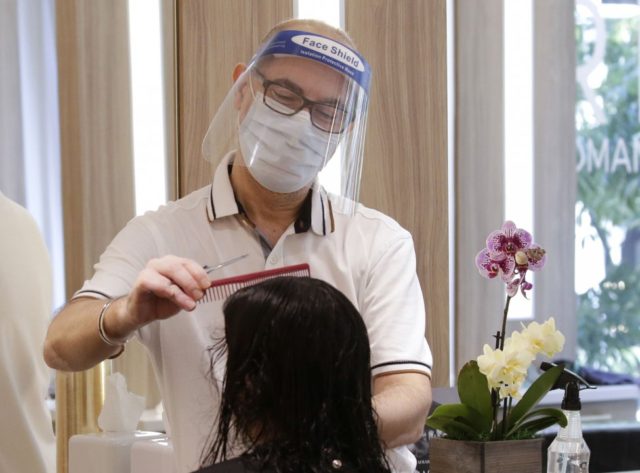Feb. 23 (UPI) — People with COVID-19 can spread the virus to others simply by talking, particularly if the speaker is not wearing a mask, a study published Tuesday by the journal Physics of Fluid found.
Exhaled air and small aerosol virus droplets released from an unmasked person who is speaking tend to move downward under the influence of gravity and scatter before attaching themselves to the nearest person, the researchers said.
The findings suggest that the flow of expelled breath near and around two people conversing in postures commonly found in the service industry, such as in hair salons, medical exam rooms or long-term care facilities, can spread the virus easily, they said.
“We analyzed the characteristics of exhalation diffusion with and without a mask when a person was standing, sitting, facing down, or lying face up,” study co-author Keiko Ishii said in a statement.
“A significant amount of similar face-to-face contact would occur not only in [salons], but also in long-term and medical care,” said Ishii, a physiologist at Nagoya University in Japan.
COVID-19 can spread from infected people when they exhale small aerosol respiratory droplets in their breath, whether or not they have symptoms of the disease.
Most studies during the pandemic looking at the flow of exhaled air have focused on coughing or sneezing, which can send aerosols flying long distances — though researchers have suggested that the virus also can spread through talking or singing.
For this study, Ishii and her colleagues used smoke and laser light to study the flow of expelled breath near and around two people conversing in postures commonly found in the service industry.
The researchers used electronic cigarettes to produce artificial smoke consisting of droplets about one-tenth of a micron in diameter, similar to the size of a virus particle.
The liquid used in vaping devices, a mixture of glycerin and propylene glycol, produces a cloud of tiny droplets that scatter light from a laser, allowing visualization of airflow patterns.
To study the effect of speech on exhalation, the word “onegaishimasu,” a Japanese greeting in a business setting, was uttered repeatedly while filming the resulting vapor cloud.
The experiments were conducted in a hair salon at the Yamano College of Aesthetics in Tokyo, with postures chosen to simulate typical customer service scenarios.
When a mask is worn while standing or sitting, the vapor cloud produced when speaking tends to attach to the speaker’s body, which is warmer than the surrounding air, according to the researchers.
If the technician is leaning over, however, the aerosol cloud tends to detach from that person’s body and fall onto the client below. If a customer or patient is lying below, they could be infected.
The spread of these aerosol droplets is even more pronounced when the speaker is unmasked.
Conversely, wearing face shields can prevent any aerosols that leak from around the speaker’s mask from traveling down to the customer.
“The face shield promoted the rise of the exhaled breath,” Ishii said.
“Hence, it is more effective to wear both a mask and a face shield when providing services to customers,” she said.

COMMENTS
Please let us know if you're having issues with commenting.